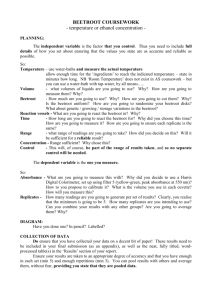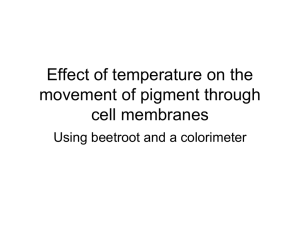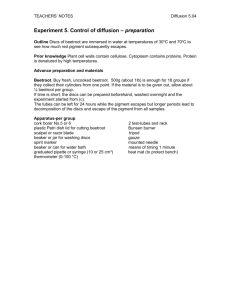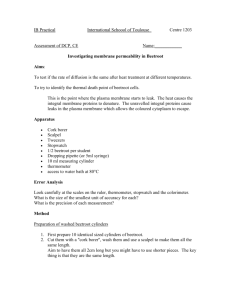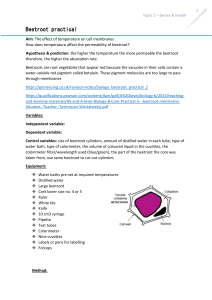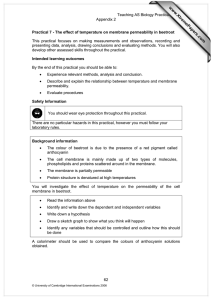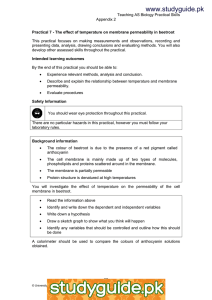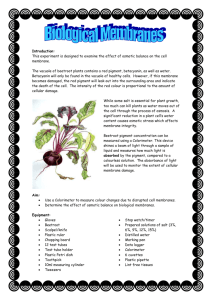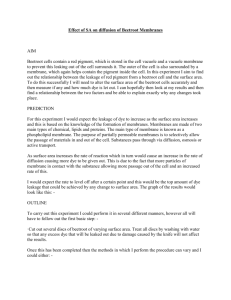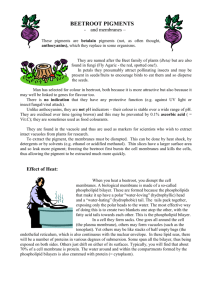WRITING UP YOUR BEETROOT EXPERIMENT
advertisement
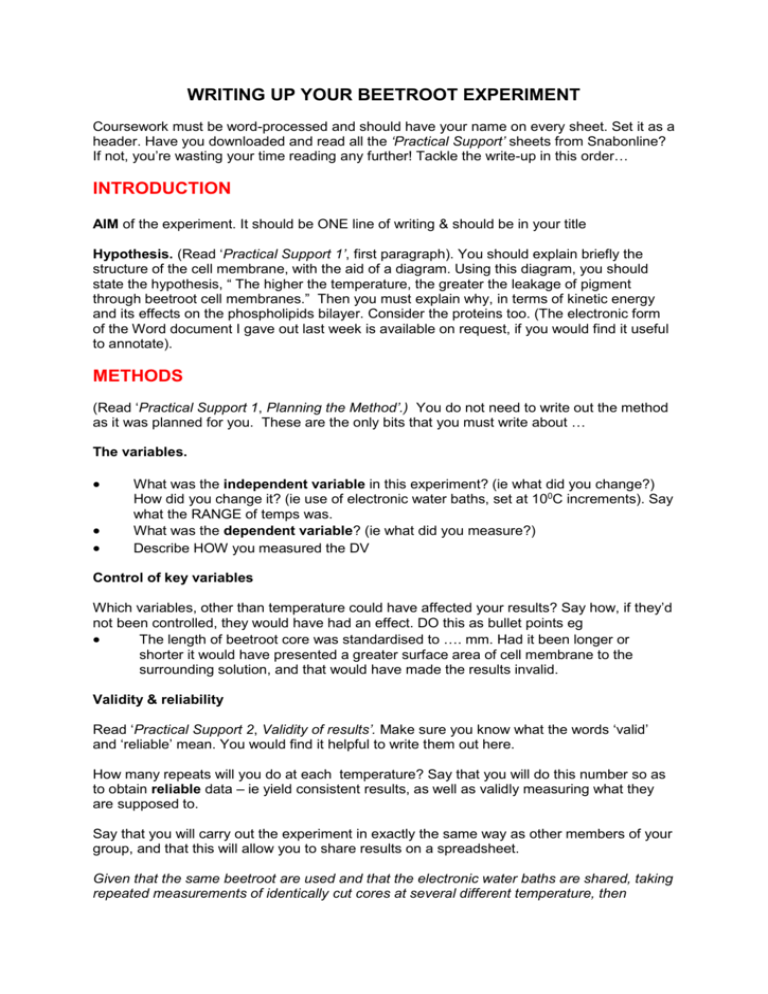
WRITING UP YOUR BEETROOT EXPERIMENT Coursework must be word-processed and should have your name on every sheet. Set it as a header. Have you downloaded and read all the ‘Practical Support’ sheets from Snabonline? If not, you’re wasting your time reading any further! Tackle the write-up in this order… INTRODUCTION AIM of the experiment. It should be ONE line of writing & should be in your title Hypothesis. (Read ‘Practical Support 1’, first paragraph). You should explain briefly the structure of the cell membrane, with the aid of a diagram. Using this diagram, you should state the hypothesis, “ The higher the temperature, the greater the leakage of pigment through beetroot cell membranes.” Then you must explain why, in terms of kinetic energy and its effects on the phospholipids bilayer. Consider the proteins too. (The electronic form of the Word document I gave out last week is available on request, if you would find it useful to annotate). METHODS (Read ‘Practical Support 1, Planning the Method’.) You do not need to write out the method as it was planned for you. These are the only bits that you must write about … The variables. What was the independent variable in this experiment? (ie what did you change?) How did you change it? (ie use of electronic water baths, set at 100C increments). Say what the RANGE of temps was. What was the dependent variable? (ie what did you measure?) Describe HOW you measured the DV Control of key variables Which variables, other than temperature could have affected your results? Say how, if they’d not been controlled, they would have had an effect. DO this as bullet points eg The length of beetroot core was standardised to …. mm. Had it been longer or shorter it would have presented a greater surface area of cell membrane to the surrounding solution, and that would have made the results invalid. Validity & reliability Read ‘Practical Support 2, Validity of results’. Make sure you know what the words ‘valid’ and ‘reliable’ mean. You would find it helpful to write them out here. How many repeats will you do at each temperature? Say that you will do this number so as to obtain reliable data – ie yield consistent results, as well as validly measuring what they are supposed to. Say that you will carry out the experiment in exactly the same way as other members of your group, and that this will allow you to share results on a spreadsheet. Given that the same beetroot are used and that the electronic water baths are shared, taking repeated measurements of identically cut cores at several different temperature, then calculating a mean for each temperature is the most valid way of measuring the effect of temperature on leakage of beetroot pigment across cell membranes Choice of apparatus In this experiment, your choice is determined by the need to obtain precise and accurate results. Read ‘Practical Support 2, Validity of results’. Make sure you know what the words ‘precise’ and ‘accurate’ mean. Again, you would find it helpful to write them out here. When you write up beetroot, you could begin by writing out the definitions, and then by saying, “ I chose electronic water baths because…” Then do the same with the other apparatus. The apparatus you choose always depends on two factors (a) (b) Whether it measures what it’s supposed to Whether it measures to the appropriate level of accuracy You cut beetroot with a corer (to ensure constant diameter) but length was measured with a ruler. To what degree of accuracy could you measure? You chose electronic water baths because they give a precise reading of temperature that rely less on human judgement than does a conventional water bath with thermometer. To what degree of accuracy did they record temperature? You also chose to use a colorimeter. Explain why. Does using a colorimeter allow you to be certain that an increase in temperature is related to an increase in leakage of pigment? To what degree of accuracy did the colorimeter read? Read Practical Support 2 again carefully: there is a good example of a colorimeter. How will YOU make sure your colorimeter readings are both accurate and precise? You should have chosen to measure volume of distilled water in an appropriate type and size of pipette. Why is a graduated pipette more accurate? ie to what level of accuracy can you read? You can’t do this with a Pasteur (squeezy) pipette. Why is one with a smaller capacity (eg 5ml), preferable to one with a larger capacity? Good advice again is found in ‘Practical Support 2, Validity of results’ & in ‘Practical Support 7, Using standard equipment’ Any changes you made from the SNAB method should be stated. Safety What general precautions (that would apply to most practicals) did you take? What specific precautions were needed for this experiment? It’s the latter that you’ll need in your Open Book Practical exam. RESULTS Presentation of results You have to PLAN for recording your own raw results during the experiment. That means writing, “ I will present my results in a …. because….” Why did you decide on a results table? If relevant, why did you decide on a spreadsheet? (This is always a better bet because one line of justification is that a spreadsheet allows processing of the data eg calculation of means). You should go to Snabonline & look at ‘Maths/stats support: 1 presenting data – tables’, and ‘2 Presenting data – graphs’. You might want to download these for your practical file. You also must justify your choice of graph for your own results (a line graph). Use the same information (above) & say, “ I will use a line graph because…” Your personal results should not be on a separate piece of paper, but should be part of the text. The corresponding graph (MEANS for each temperature only, with error bars) should follow your results. Using the CLASS results (especially from a spreadsheet) provides more opportunity. Include the spreadsheet in your writeup. Make sure you’ve shown where your results are. Calculate means for each temperature, & calculate standard error. If you can, draw error bars from this standard error figure in Excel. They’ll be more meaningful than those on your own graph. DISCUSSION Read the excellent advice in ‘Practical Support 1, Discussion’. Follow each bullet point in succession & answer each one, preferably in bulleted sections. Don’t write the question out & then an answer underneath! If you’re stuck for how to actually write it, you could simply use subheadings derived from the questions. The evidence that supports your conclusion should be relatively detailed. If you have this detail in your hypothesis, copy & paste. Bullet point 7 requires you to look at validity (again) and error. Read Practical Support 3, Error. Define systematic error and random error. You will have random error in your results, despite working carefully to reduce it. Find a good reason for random error. Systematic error may have crept in. Did you compare a reading from a slightly cloudy cuvette with one from a brand new one, as advised.? Good. Quote the difference. You can then say that several results may have been systematically affected by not having a constant source of new cuvettes (you can’t say this if you didn’t bother!) If you did have a slightly cloudy cuvette, this will have affected accuracy and validity. Did you keep checking the water baths’ temperatures? And the temperature inside your boiling tube? One water bath is not calibrated very well. While the dial on the outside reads a certain temperature, a thermometer inside records a 20oC difference. Systematic error! Bullets 8 and 9 ask you to comment on limitations of your results separately from limitations of your apparatus. Be careful to do so. Now use class results. These provide more information. How much more? Use the standard deviations. At the very least you will be able to say, “ Results at …0C show a large standard deviation. This means they are less reliable than those for …oC that have a much smaller standard deviation” SUMMARY Again, read the excellent advice in ‘Practical Support 1, Summary’. Do this summary for practice. You could put it at the beginning, as suggested, and call it ‘Abstract’.
